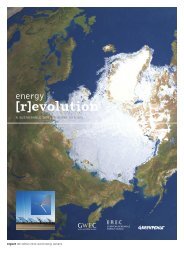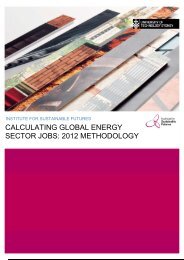download the mexico energy revolution scenario
download the mexico energy revolution scenario
download the mexico energy revolution scenario
Create successful ePaper yourself
Turn your PDF publications into a flip-book with our unique Google optimized e-Paper software.
The charts in Figure 2.5 show for <strong>the</strong> US, EU, India and China, <strong>the</strong><br />
relationship between domestic emissions reductions under <strong>the</strong> Energy<br />
[R]evolution <strong>scenario</strong>s and <strong>the</strong> allocation of responsibility through<br />
<strong>the</strong> GDR framework. For <strong>the</strong> EU and <strong>the</strong> US, <strong>the</strong> allocations (solid<br />
blue and green lines) are well below <strong>the</strong> estimated emissions (dotted<br />
blue and green lines), with <strong>the</strong> difference resulting from an<br />
international obligation to fund reductions in o<strong>the</strong>r countries. In India<br />
and China, by contrast, <strong>the</strong> allocation of permits is greater than <strong>the</strong><br />
estimated emissions, indicating that o<strong>the</strong>r countries will need to<br />
support a reduction from <strong>the</strong> level indicated by <strong>the</strong> allocation (solid<br />
lines) and projected emissions (dashed lines).<br />
Because <strong>the</strong> forward calculation of <strong>the</strong> Responsibility and Capacity<br />
Indicator (RCI) depends on <strong>the</strong> budget that is allocated, <strong>the</strong><br />
percentage reductions of different countries and regions are slightly<br />
different under <strong>the</strong> Energy [R]evolution and advanced Energy<br />
[R]evolution pathways. Never<strong>the</strong>less, because nei<strong>the</strong>r capacity nor<br />
responsibility from 1990-2010 vary in <strong>the</strong> two <strong>scenario</strong>s, <strong>the</strong> RCIs<br />
figure 2.5: annual ghg emissions and reduction pathways allocated<br />
under <strong>the</strong> GDR system for <strong>the</strong> USA, Europe, China and India<br />
image WIND TURBINES AT THE NAN<br />
WIND FARM IN NAN’AO. GUANGDONG<br />
PROVINCE HAS ONE OF THE BEST WIND<br />
RESOURCES IN CHINA AND IS ALREADY<br />
HOME TO SEVERAL INDUSTRIAL SCALE<br />
WIND FARMS.<br />
for specific countries are still quite similar, and thus <strong>the</strong> actual<br />
allocations going forward differ between <strong>the</strong> two <strong>scenario</strong>s primarily<br />
because of <strong>the</strong> stricter targets in <strong>the</strong> advanced <strong>scenario</strong>.<br />
It is also important to note that because GDRs allocate obligations<br />
as a percentage of <strong>the</strong> global commitment, measured in MtCO2 in this<br />
example, a country with lower per capita emissions will appear to<br />
have a more stringent reduction target, when <strong>the</strong>ir target is stated in<br />
terms of a percentage of 1990 emissions by 2020 or 2030. However,<br />
it should be borne in mind that <strong>the</strong> GDR calculation does not specify<br />
<strong>the</strong> split between domestic and internationally supported reductions.<br />
Since we assume that emissions trading or a similar mechanism will<br />
lead to a rough equalisation of <strong>the</strong> marginal cost of reductions, it is<br />
in essence <strong>the</strong> “per capita tonnes of reductions”, and thus per capita<br />
costs, which are made comparable (not equal) through <strong>the</strong><br />
calculation of <strong>the</strong> RCI. With this in mind, we can see under <strong>the</strong><br />
Energy [R]evolution <strong>scenario</strong> that <strong>the</strong> OECD nations have a global<br />
responsibility equal to a reduction to 45% below 1990 levels in<br />
2020 and 2% of 1990 levels in 2030.<br />
© GP/XUAN CANXIONG<br />
2<br />
implementing <strong>the</strong> <strong>energy</strong> [r]evolution | GREENHOUSE DEVELOPMENT RIGHTS<br />
5,000<br />
European Union<br />
6,000<br />
United States<br />
annual CO2 emissions (Mt CO2)<br />
4,000<br />
3,000<br />
2,000<br />
1,000<br />
percent of CO2 emissions<br />
annual CO2 emissions (Mt CO2)<br />
5,000<br />
4,000<br />
3,000<br />
2,000<br />
1,000<br />
percent of CO2 emissions<br />
0<br />
-500<br />
1990 1995 2000 2005 2010 2015 2020 2025 2030<br />
0<br />
1990 1995 2000 2005 2010 2015 2020 2025 2030<br />
12,000<br />
China<br />
4,000<br />
India<br />
annual CO2 emissions (Mt CO2)<br />
10,000<br />
8,000<br />
6,000<br />
4,000<br />
2,000<br />
percent of CO2 emissions<br />
annual CO2 emissions (MtCO2)<br />
3,000<br />
2,000<br />
1,000<br />
percent of CO2 emissions<br />
0<br />
0<br />
1990 1995 2000 2005 2010 2015 2020 2025 2030<br />
1990 1995 2000 2005 2010 2015 2020 2025 2030<br />
BUSINESS AS USUAL<br />
ENERGY [R]EVOLUTION PATHWAY<br />
GDRS ALLOCATION UNDER ENERGY [R]EVOLUTION<br />
ENERGY [R]EVOLUTION PATHWAY<br />
GDRS ALLOCATION UNDER ADVANCED ENERGY [R]EVOLUTION<br />
27



![Energy [R]evolution - European Commission](https://img.yumpu.com/49109324/1/184x260/energy-revolution-european-commission.jpg?quality=85)


![5905 gp [eu rev]csfr4.qxd - Energy [R]evolution](https://img.yumpu.com/42305023/1/184x260/5905-gp-eu-revcsfr4qxd-energy-revolution.jpg?quality=85)


![5905 gp [eu rev]csfr4.qxd - Energy [R]evolution](https://img.yumpu.com/28729264/1/184x260/5905-gp-eu-revcsfr4qxd-energy-revolution.jpg?quality=85)